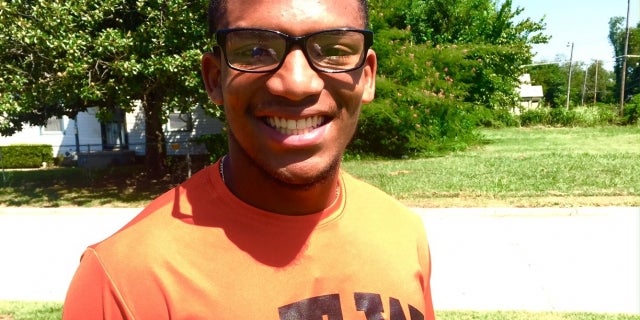“I’ve played football my whole life basically,” 17-year old William McKenney shares from his Tulsa home on a humid August afternoon. In just a few short hours, he will return to Booker T. Washington High School for six hours of pre-season football practice. “I love it. You’ve got to love the game to play it. I love the game.” The senior safety doesn’t mind putting in the work. After all, this is arguably the most important season of his career. “After high school I’d like to go on and if I get the opportunity to play college football and move onto the next level and play in the NFL, I’ll do that. If not, I’ve always got to have a backup plan.”
To prepare for the upcoming season, last spring the Booker T. Washington athletic department encouraged student athletes participate in a heart screening provided by the Chase Morris Foundation - dedicated to raising awareness of sudden cardiac death among student athletes following the death of 16-year old high school athlete Chase Morris in 2013.
William’s mother, Samico, signed the release to have her son screened with his team. “I missed his call,” she remembers looking down to see several missed calls from William. “He’s never done that before. Then emails starting popping up in the midst of the calls, saying I needed to get an appointment set up immediately regarding William’s heart.”
Although neither William nor Samico would have expected anything abnormal from the heart screening, the doctor reading the scan told William, “That I had a hole in my heart. He told me everyone is born with a hole in their heart and it was just unfortunate that the hole in my heart didn’t close. I would eventually have to have surgery.”
“It’s a natural instinct to worry,” William says of trying to make sense of this news and wondering what was wrong with his heart. His mother worried also. Samico called his lifelong pediatrician to review his medical records, looking for any sign that something was wrong with his heart. She also began calling family to learn of possible hereditary heart problems. Samico couldn’t find anything that would have indicated there was a problem with William’s heart.
“I wanted a second opinion,” says Samico before agreeing to surgery. She found Director of Cardiovascular Magnetic Resonance Imaging at Oklahoma Heart Institute Dr. Edward Martin.
“William presented to me with an abnormal ultrasound of the heart, done at an outside institution, which suggested a large atrial septal defect or communication between the upper right and left chambers of the heart,” says Dr. Martin. “He is an excellent football player and had plans to play football beyond high school. We talked about the timing of a potential surgery and how that would impact, but not end, his football career.”
Potentially facing surgery months before the start of football practice, William said the reality of recovering from surgery flashed through his mind, “I wouldn’t be able to play my senior year.”
“I’ve watched him deal with the pain of breaking his knee cap,” says Samico when William was in the fourth grade. “I had to endure watching him sit back and watch his teammates. Thinking that I would watch him sit out his senior year - this is his moment - I really didn't want anything to interfere with the last year of football, because this is his heart. This is what he loves to do.”
“Because congenital heart disease can be highly complex and because ultrasound imaging can be limited in its resolution, I had William undergo a Cardiovascular MRI here at Oklahoma Heart Institute to get a complete picture of his heart and blood vessel anatomy,” shares Dr. Martin.
William met with Dr. Martin before his cardiovascular MRI. “He told me, ‘don’t worry about anything,’” William recalls. “He said he was going to look at the results when we were done.”
“I think we were all shocked, but pleasantly so, when the MRI revealed a normal heart,” shares Dr. Martin.
“It was a relief,” adds William. “Now I knew I didn’t have to have the surgery. I didn’t have to worry about being put out of the game.”
When William steps on to the field each game this season, he says he will have more confidence, knowing his heart is just fine. “You never know what could happen,” he adds.” If you have the opportunity to get your body checked out, get your heart checked out - take it.”
“I believe this highlights the need for accurate high resolution imaging procedures,” explains Dr. Martin, “before undertaking something as life altering as heart surgery.”
An estimated one out of 200,000 high school student-athletes die each year, according to a Minnesota study of 1.4 million student-athlete participants in 27 sports over a 12-year period. “Although the frequency of deaths in young athletes appears to be relatively low, such deaths are undoubtedly more common than previously thought and represent a substantive public health problem,” adds Dr. Martin. “The Chase Morris Foundation is a great idea in that it promotes the screening of athletes of high school age to rule out life threatening heart diseases. Then if an abnormality is suspected the athlete should seek an opinion from a qualified cardiovascular specialist for more detailed evaluation process. In this case there was a definite happy ending.”
The Chase Morris Foundation heart screening was an opportunity that allows William to pursue his football career even further, but if that doesn’t work out, he has a backup plan. “I’m debating either becoming a chemical engineer or going to the air traffic control institute. That’s just a little backup plan.”
For more information about cardiovascular MRI at Oklahoma Heart Institute, please click here.

